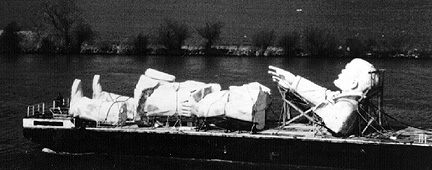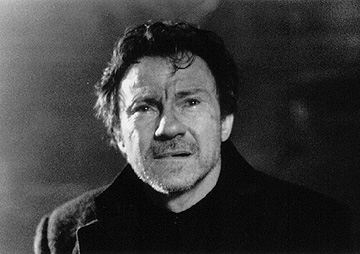


FILM REVIEWS
AND CALENDAR

A Balkan Odyssey of Epic Proportions
by Paul D. Goetz
Free Press staff writer
In the uninterrupted eight-minute crane shot that opens The Player, that corrosive 1992 satire of the Hollywood studio system, director Robert Altman takes a jab at the brainless quick-cutting that artificially juices much of today's cinema: "The pictures they make these days are all MTV - cut, cut, cut," says the studio's security chief to a mail boy. Altman also provides an ironic sense of self-incrimination as the camera captivatingly swoops over a studio lot in an artificial way the eye could never see. Yet, voluminous cutting and the moving camera in themselves do not make cinema inane. Effective rapid-fire editing can bring meaning to a film as early as The Maltese Falcon or to one as recent as Trainspotting. The fluidly propelled camera can provide profundity in films as dissimilar as The Earrings of Madame de... and Three Colors: Red. But the thrills provided by the crane and the Steadicam are, in Hollywood, more often calculated for impersonal effect and feed into our asinine hunger for higher levels of sensory stimulation. One might suggest that every time a cut is made, a border is erected between one shot and the next. Is this rampant splintering of attention a metaphor for an increasingly divided world?
The real problem is that American filmmakers, audiences, and especially major studio executives have become so enamored of the trappings of vitality that theme and even plot have become superfluous. Even pyrotechnics and computer-generated special effects have taken precedence over meaning and story. Like a powerful drug, this evolving language of the American cinema diminishes attention spans and is difficult to give up, while voices originating in other countries, powerful in their own right, seem dull by comparison.
This assessment has never been more true in light of the works of the great - and still largely marginalized - Greek director Theo Angelopoulos, whose films are apparently a hard sell for American distributors for they are rarely seen here outside film festivals. His latest, Ulysses' Gaze, a prize-winner at the 1995 Cannes film festival, has had to wait until this year to arrive in limited release. (It will have its local premiere at the Seattle International Film Festival just prior to its week-long run at the Varsity Theater.)
In recent years, Angelopoulos and his brilliant cinematographer Yorgos Arvanitis have made personal, poetic road movies - epic physical and spiritual journeys crossing many borders in which a sense of home is uncertain. They are mythical and melancholy yet bracing in their directness. The journeys are often dangerous and dispiriting - border crossings are rife with tension, and desolate landscapes are charged with an air of terrible wonder, but there is something binding and even hopeful in the organic, nearly unbroken way in which the sequences are filmed. The films keenly observe the world with lengthy takes and assured movements of the camera, calmly waiting for each scene's essence to unfold before moving on. They render everything in focus and therefore make everything relevant, connecting us to the world in both a naturalistic and nearly fantastic way.
Intersecting in interesting ways with Homer's myth (though in Angelopoulos's words, "more for contrast than for imitation"), Ulysses' Gaze features Harvey Keitel in a brave performance as a weary Greek-American filmmaker known only as A. who has returned to Greece after 35 years to attend the screening of one of his films in Florina where he was stationed. He's also been asked by the Athens Film Archive to supervise a documentary on the film pioneers Yannakis and Miltos Manakis. He's been told of the existence of three rolls of undeveloped film shot by the brothers that may be the first film shot in the Balkans. (A tantalizing glimpse of this "film" may be found in Angelopoulos's 52-second contribution to Lumiere and Company, a 1995 collection of shorts made by dozens of world directors with a restored Lumiere camera as a 100-year anniversary tribute to the pioneering Lumiere brothers.)
 Soon, he embarks on a journey to "set free at the end of the century the captive gaze from the beginning of the century." Outwardly, it takes him from Greece to Albania, from Bulgaria to Romania, to Constanta on the Black Sea, along the Danube to the former Yugoslavia including Belgrade, and finally to war-torn Sarajevo. But Angelopoulos is also after A.'s interior journey - a personal, obsessive search for his own lost innocence, a journey filled with longing for no less than the birth of his soul.
Soon, he embarks on a journey to "set free at the end of the century the captive gaze from the beginning of the century." Outwardly, it takes him from Greece to Albania, from Bulgaria to Romania, to Constanta on the Black Sea, along the Danube to the former Yugoslavia including Belgrade, and finally to war-torn Sarajevo. But Angelopoulos is also after A.'s interior journey - a personal, obsessive search for his own lost innocence, a journey filled with longing for no less than the birth of his soul.
All the while, Angelopoulos refers to the tumultuous history of the Balkans even as he allows A.'s personal history to share the frame with the present in a dream-like way. When he gets off a train in Bucharest, for example, he meets his mother in 1945 as a young woman who takes him to Constanta, where his extended family has gathered, and he seamlessly re-experiences the sinister intrusion of Romanian Communism on the happiness of three New Year's eve parties. The poetic, somnambulistic way in which he and other characters talk may be off-putting to some, but to my ears it gives the film, together with Eleni Karaindrou's haunting score, the effect of an extended incantation and the solitude of prayer. Clearly, Angelopoulos intends an embryonic state as though we and A. have entered the darkness of a womb in which the whole of Balkan history resides. As A.'s Greek contact says, "Balkan reality is sailing dark waters now."
The cycle of birth, death, and rebirth resonates throughout the film; especially in the use of the brilliant Romanian actress Maia Morgenstern in several roles. It's an impressive stratagem that emphasizes the universality of the Balkan story, but also contributes to Angelopoulos's concept of the fluidity of time and space. In one sequence, she's a Monastir film archivist who shows A. the withered quiescence of his heart. In another, she's very moving as a traumatized Serbian widow who clothes A. in the garments of her dead husband in the ruins of the house where they must have loved and laughed. Finally, she's a young Jewish woman amidst the horrors of Sarajevo during wartime, who coaxes the beginnings of a rebirth of his heart. Erland Josephson has a crucial part as her father, a "collector of vanished gazes," who may be able to develop the Manakis's film in his small lab in the ruins of a cinema.
Most directors use the cinema simply to illustrate the connecting of narrative dots. Angelopoulos is a director for whom "story" is found in the images themselves - the collision of two groups of demonstrators in darkened Florina, one carrying umbrellas, the other bearing torches impresses on us with the power of the cinema, of "the gaze" to provoke and divide. A barge carrying the gargantuan remains of a statue of Lenin up the Danube with a Lilliputian A. at its side sums up the fall of Communism, yes, but also engraves upon us the monumental absurdity and tragedy of all dictatorial schemes. The emptiness of Sarajevo, as cars burn in the street and later vanish in fog, causing the snipers to pause and musicians to take back the streets, may have no basis in reality, but transmits the truth of the tenacity of survivors in an impossible dilemma.
These are resonant images that come to us as self-discoveries - that seek to awaken in us the innocence of the first gaze. In the length, breadth, and depth of them, they seek to provide an antidote to the splintering of peoples and nations, to visualize the contiguous spiritual foundation beneath the fractured world. While Hollywood seeks to grab the attention and hold it in blatantly superficial ways, Angelopoulos succeeds in illuminating the tragic self-destructiveness of the world and the hope of individuals who refuse to give up the journey, with arresting images the eye seems capable of discovering on its own.
Dong's latest documentary (which also has a screening at this month's Seattle International Film Festival) features interviews with six men currently serving time for murdering homosexuals. It's a curious experience; a little like being asked to monitor an experiment from inside the petri dish. With their outwardly reasonable voices and dissociative minds, it's difficult to know which words to trust. Some are certainly psychopaths, such as the remorseless Jeffrey Swinford, who nearly forgot about the murder afterward, and the confused army sergeant Kenneth French, who randomly shot and killed four people in a restaurant after raving about Clinton lifting the ban on gays and lesbians in the military. One senses that these men would have found other paths to perdition had circumstances been different. But others like Jay Johnson, a religiously hostile, self-loathing homosexual, and Donald Aldrich, who seemed to have had a well-thought-out modus operandi enabled by a system prior to the institution of hate-crime statutes, certainly support Dong's premise that society contributes to the ease with which they turned deadly. Though Dong brings in additional materials, such as Jerry Falwell and Pat Robertson spouting off, news reports, courtroom footage, and grisly stills from police files, these mostly just contribute to an atmosphere of immobilizing horror - powerful, yes, yet anything but empowering.
by Lori Wahlers
What does this mean to you and the rest of the general public? We deserve to have access to all of the information available to protect ourselves from illness. Especially for people who test positive for HIV or are diagnosed with AIDS, having all the facts can literally mean the difference between life and death. Most significantly, increasing success is being reported about those who have used alternative treatment methods, and are alive, healthy, and symptom-free today.
See a Movie, Save a Life
Free Press contributor
[Ed's note: The author is active with HEAL (Health Education AIDS Liaison), an organization which challenges the HIV/AIDS hypothesis. The Free Press welcomes debate on this topic and hopes to cover it in a future issue.]
A new documentary film, HIV = AIDS: Fact or Fraud?, reveals the dissension among top scientists worldwide about what really causes AIDS. Over 400 respected scientists, including three Nobel laureates, have officially called for a scientific reappraisal of the hypothesis that HIV is the virus that causes AIDS. Evidence suggests that HIV may be only indirectly associated with AIDS, and might not be the actual cause of the disease. The film reveals that much of what medical authorities have led the public to believe about HIV and AIDS is incorrect. Conversely, alternative theories have not been reported in the mainstream press.
Come see the documentary HIV = AIDS: Fact or Fraud? and learn what you need to know. The film will be shown at the Velvet Elvis, 107 Occidental Ave S. in Seattle's Pioneer Square area and at other locations. For info call the Velvet Elvis (206) 624-8477 or HEAL (206) 391-6910.
[Home]
[This Issue's Directory]
[WFP Index]
[WFP Back Issues]
[E-Mail WFP]





Contents this page were published in the May/June, 1997 edition of the Washington Free Press.
WFP, 1463 E. Republican #178, Seattle, WA -USA, 98112. -- WAfreepress@gmail.com
Copyright © 1997 WFP Collective, Inc.